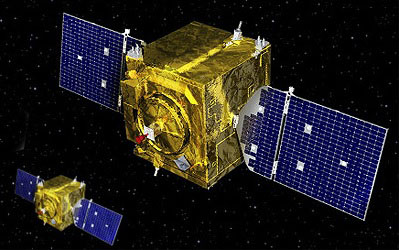Special to CosmicTribune.com, May 2, 2023
By Richard Fisher
In geosynchronous orbit (GEO) China and the United States are revealing “sharp elbows” or potential combat capabilities that reflect the very high priority both place on war-winning access to low Earth orbit (LEO) and GEO, and just as important, to deny such access to the other.
GEO is about 22,000 miles in altitude above the Earth’s surface, where a satellite usually inhabits an orbit that is constantly above a targeted region of the Earth.

During March 14 testimony before the Senate Armed Services Committee, Chief of the U.S. Space Force Gen. Chance Saltzman warned that China is “likely pursuing anti-satellite systems able to destroy satellites in geosynchronous orbit… They are testing on-orbit satellite systems which could be weaponized as they have already shown the capability to physically control and move other satellites.”
In addition, Saltzman noted that China’s People’s Liberation Army (PLA) is developing ground-based lasers, electronic warfare jamming systems that target U.S. Global Positioning System (GPS) navigation and U.S. communication satellites, in addition to ground-based anti-satellite missile interceptors.
For the United States Department of Defense, GEO is used to place communications, data relay and crucial Defense Support Program (DPS) satellites that provide early warning of strategic nuclear missile attack from China and Russia.
Therefore, destroying DPS satellites would be a high priority in order to conduct a nuclear “First Strike” against the United States.
The PLA also uses GEO to place at least three Houyan early missile warning satellites over the Indian Ocean, South China Sea and Oceania, and at least three Qianshao signals intelligence (SIGINT) gathering satellites.
In addition, the PLA places Tianlian data relay and Beidou navigation satellites in GEO.
On Jan. 22, 2022, the Chinese SJ-21 grappling satellite grabbed a dead Chinese Beidou navigation satellite in GEO and moved to an inoperative orbit, demonstrating that the SJ-21 could also be used to grab and neutralize U.S. satellites in GEO.
But the U.S. is also monitoring Chinese satellites in GEO, using its Geosynchronous Space Situational Awareness Program (GSSAP) satellites, six of which have been launched between 2014 and 2022.
A May 8 report in the South China Morning Post (SCMP) offered a rare Chinese revelation of U.S. surveillance of Chinese satellites, noting that U.S. GSSAP satellites, “carried out at least 14 close-in reconnaissance missions on Chinese high-orbit satellites in less than two years.”
SCMP further noted, “From February 2020 to December 2021 the US Air Force’s Geosynchronous Space Situational Awareness Programme (GSSAP) satellites repeatedly approached some of China’s most valuable and advanced satellites in the geostationary orbit (GEO) and came alarmingly close…”
“The frequent close approaches of the GSSAP satellite to Chinese high-value space assets pose a serious threat to their security…In a series of space attack and defense technology tests, the US military has revealed their ability and intention to disrupt China’s use of space.”
The article further noted, according to SCMP, “A GSSAP satellite conducted a fly-around targeting Tianlian 2-01, a satellite that is part of China’s Tianlian space tracking and data relay system on February 26, 2020…The Tianlian system provides communication links between spacecraft in orbit and ground stations on Earth and supports China’s human space flight program and other space activities.”

Full Text . . . . Current Edition . . . . Subscription Information

You must be logged in to post a comment Login